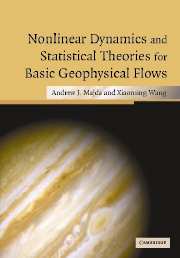Book contents
- Frontmatter
- Contents
- Preface
- 1 Barotropic geophysical flows and two-dimensional fluid flows: elementary introduction
- 2 The response to large-scale forcing
- 3 The selective decay principle for basic geophysical flows
- 4 Non-linear stability of steady geophysical flows
- 5 Topographic mean flow interaction, non-linear instability, and chaotic dynamics
- 6 Introduction to information theory and empirical statistical theory
- 7 Equilibrium statistical mechanics for systems of ordinary differential equations
- 8 Statistical mechanics for the truncated quasi-geostrophic equations
- 9 Empirical statistical theories for most probable states
- 10 Assessing the potential applicability of equilibrium statistical theories for geophysical flows: an overview
- 11 Predictions and comparison of equilibrium statistical theories
- 12 Equilibrium statistical theories and dynamical modeling of flows with forcing and dissipation
- 13 Predicting the jets and spots on Jupiter by equilibrium statistical mechanics
- 14 The statistical relevance of additional conserved quantities for truncated geophysical flows
- 15 A mathematical framework for quantifying predictability utilizing relative entropy
- 16 Barotropic quasi-geostrophic equations on the sphere
- Index
1 - Barotropic geophysical flows and two-dimensional fluid flows: elementary introduction
Published online by Cambridge University Press: 30 November 2009
- Frontmatter
- Contents
- Preface
- 1 Barotropic geophysical flows and two-dimensional fluid flows: elementary introduction
- 2 The response to large-scale forcing
- 3 The selective decay principle for basic geophysical flows
- 4 Non-linear stability of steady geophysical flows
- 5 Topographic mean flow interaction, non-linear instability, and chaotic dynamics
- 6 Introduction to information theory and empirical statistical theory
- 7 Equilibrium statistical mechanics for systems of ordinary differential equations
- 8 Statistical mechanics for the truncated quasi-geostrophic equations
- 9 Empirical statistical theories for most probable states
- 10 Assessing the potential applicability of equilibrium statistical theories for geophysical flows: an overview
- 11 Predictions and comparison of equilibrium statistical theories
- 12 Equilibrium statistical theories and dynamical modeling of flows with forcing and dissipation
- 13 Predicting the jets and spots on Jupiter by equilibrium statistical mechanics
- 14 The statistical relevance of additional conserved quantities for truncated geophysical flows
- 15 A mathematical framework for quantifying predictability utilizing relative entropy
- 16 Barotropic quasi-geostrophic equations on the sphere
- Index
Summary
Introduction
The atmosphere and the ocean are the two most important fluid systems of our planet. The bulk of the atmosphere is a thin layer of air 10 km thick that engulfs the earth, and the oceans cover about 70% of the surface of our planet. Both the atmosphere and the ocean are in states of constant motion where the main source of energy is supplied by the radiation of the sun. The large-scale motions of the atmosphere and the ocean constitute geophysical flows and the science that studies them is geophysical fluid dynamics. The motions of the atmosphere and the ocean become powerful mechanisms for the transport and redistribution of energy and matter. For example, the motion of cold and warm atmospheric fronts determine the local weather conditions; the warm waters of the Gulf Stream are responsible for the temperate climate in northern Europe; the winds and the currents transport the pollutants produced by industries. It is clear that the motions of the atmosphere and the ocean play a fundamental role in the dynamics of our planet and greatly affect the activities of mankind.
It is apparent that the dynamical processes involved in the description of geophysical flows in the atmosphere and the ocean are extremely complex. This is due to the large number of physical variables needed to describe the state of the system and the wide range of space and time scales involved in these processes.
- Type
- Chapter
- Information
- Publisher: Cambridge University PressPrint publication year: 2006



